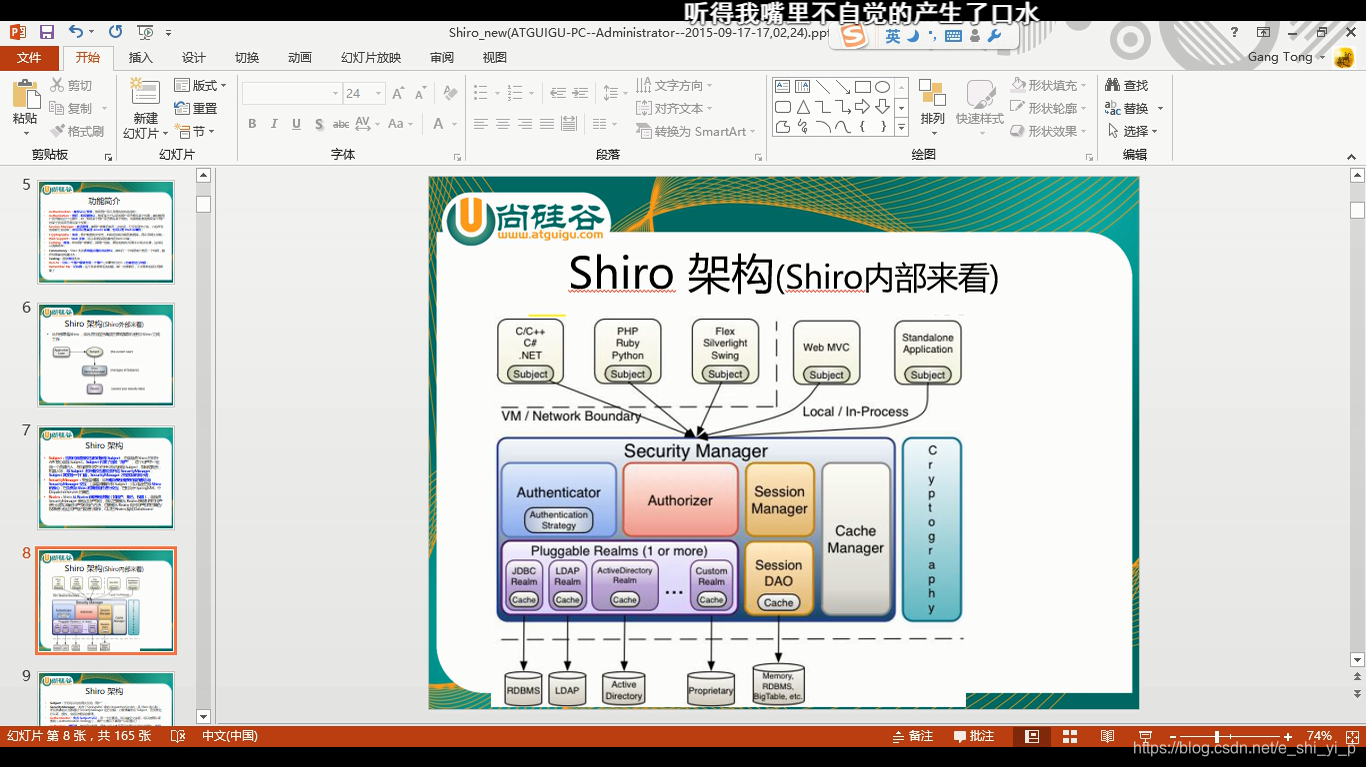1、实现思路:工厂启动时加载 .ini文件权限、用户、角色信息到一个集合中
2、通过 工厂获取 SecurityManager 组件
3、通过 SecurityUtils.getSubject(); 获取用户组件
Subject:应用代码直接交互的对象是 Subject,也就是说 Shiro 的对外API 核心就是 Subject
4、Subject 中获取session
5、subject 是操作入口 currentUser.isAuthenticated() 认证
currentUser.login(token) 登录\currentUser.hasRole(“schwartz”) 角色
currentUser.isPermitted(“user:delete:zhangsan”) 权限
currentUser.logout(); 退出登录
SecurityManager:安全管理器;即所有与安全有关的操作都会与SecurityManager 交互;且其管理着所有 Subject;可以看出它是 Shiro的核心,
它负责与 Shiro 的其他组件进行交互,它相当于 SpringMVC 中DispatcherServlet 的角色(任务调度中心)、
SecurityManager中的组件_____Session Manager:会话管理,即用户登录后就是一次会话,在没有退出之前,它的所有信息都在会话中即用户登录后就是一次会话,在没有退出之前,它的所有信息都在会话中
shiro.ini 文件配置
[users]
# user 'root' with password 'secret' and the 'admin' role
root = secret, admin
# user 'guest' with the password 'guest' and the 'guest' role
guest = guest, guest
presidentskroob = 12345, president
# user 'darkhelmet' with password 'ludicrousspeed' and roles 'darklord' and 'schwartz'
darkhelmet = ludicrousspeed, darklord, schwartz
# user 'lonestarr' with password 'vespa' and roles 'goodguy' and 'schwartz'
lonestarr = vespa, goodguy, schwartz
#用户 密码 角色1,角色2
# -----------------------------------------------------------------------------
# Roles with assigned permissions
[roles]
#针对上面的角色 有什么权限呢,可以做什么 有什么权利
# 'admin' role has all permissions, indicated by the wildcard '*'
admin = *
# The 'schwartz' role can do anything (*) with any lightsaber:
schwartz = lightsaber:*
goodguy = user:delete:zhangsan

public class Quickstart {
private static final transient Logger log = LoggerFactory.getLogger(Quickstart.class);
public static void main(String[] args) {
Factory<SecurityManager> factory = new IniSecurityManagerFactory("classpath:shiro.ini");
SecurityManager securityManager = factory.getInstance();
SecurityUtils.setSecurityManager(securityManager);
// Now that a simple Shiro environment is set up, let's see what you can do:
// get the currently executing user:
// 获取当前的 Subject. 调用 SecurityUtils.getSubject();
Subject currentUser = SecurityUtils.getSubject();
// Do some stuff with a Session (no need for a web or EJB container!!!)
// 测试使用 Session
// 获取 Session: Subject#getSession()
Session session = currentUser.getSession();
session.setAttribute("someKey", "aValue");
String value = (String) session.getAttribute("someKey");
if (value.equals("aValue")) {
log.info("---> Retrieved the correct value! [" + value + "]");
}
// let's login the current user so we can check against roles and permissions:
// 测试当前的用户是否已经被认证. 即是否已经登录.
// 调动 Subject 的 isAuthenticated()
if (!currentUser.isAuthenticated()) {
// 把用户名和密码封装为 UsernamePasswordToken 对象
UsernamePasswordToken token = new UsernamePasswordToken("lonestarr", "vespa");
// rememberme
token.setRememberMe(true);
try {
// 执行登录.
currentUser.login(token);
}
// 若没有指定的账户, 则 shiro 将会抛出 UnknownAccountException 异常.
catch (UnknownAccountException uae) {
log.info("----> There is no user with username of " + token.getPrincipal());
return;
}
// 若账户存在, 但密码不匹配, 则 shiro 会抛出 IncorrectCredentialsException 异常。
catch (IncorrectCredentialsException ice) {
log.info("----> Password for account " + token.getPrincipal() + " was incorrect!");
return;
}
// 用户被锁定的异常 LockedAccountException
catch (LockedAccountException lae) {
log.info("The account for username " + token.getPrincipal() + " is locked. " +
"Please contact your administrator to unlock it.");
}
// ... catch more exceptions here (maybe custom ones specific to your application?
// 所有认证时异常的父类.
catch (AuthenticationException ae) {
//unexpected condition? error?
}
}
//say who they are:
//print their identifying principal (in this case, a username):
log.info("----> User [" + currentUser.getPrincipal() + "] logged in successfully.");
//test a role:
// 测试是否有某一个角色. 调用 Subject 的 hasRole 方法.
if (currentUser.hasRole("schwartz")) {
log.info("----> May the Schwartz be with you!");
} else {
log.info("----> Hello, mere mortal.");
return;
}
//test a typed permission (not instance-level)
// 测试用户是否具备某一个行为. 调用 Subject 的 isPermitted() 方法。
if (currentUser.isPermitted("lightsaber:weild")) {
log.info("----> You may use a lightsaber ring. Use it wisely.");
} else {
log.info("Sorry, lightsaber rings are for schwartz masters only.");
}
//a (very powerful) Instance Level permission:
// 测试用户是否具备某一个行为.
if (currentUser.isPermitted("user:delete:zhangsan")) {
log.info("----> You are permitted to 'drive' the winnebago with license plate (id) 'eagle5'. " +
"Here are the keys - have fun!");
} else {
log.info("Sorry, you aren't allowed to drive the 'eagle5' winnebago!");
}
//all done - log out!
// 执行登出. 调用 Subject 的 Logout() 方法.
System.out.println("---->" + currentUser.isAuthenticated());
currentUser.logout();
System.out.println("---->" + currentUser.isAuthenticated());
System.exit(0);
}
借鉴:https://blog.csdn.net/qq_20641565/article/details/78772938
由上述流程可以推测,spring整合shiro后流程如下:
spring容器\bean工厂启动时
加载ShiroFilter 的 bean 中信息进入map
认证、授权 bean__继承_AuthorizingRealm 得到权限set<string>
web.xml中对每一次请求进行拦截
//如果没有认证__会跳转到自定义登录页、那些访问资源可以直接访问
//每一次请求时会比对
//登录只会执行一次
//权限认证__每一次请求都会执行、得到权限set 根据页面的shiro标签实现显示、隐藏-------------